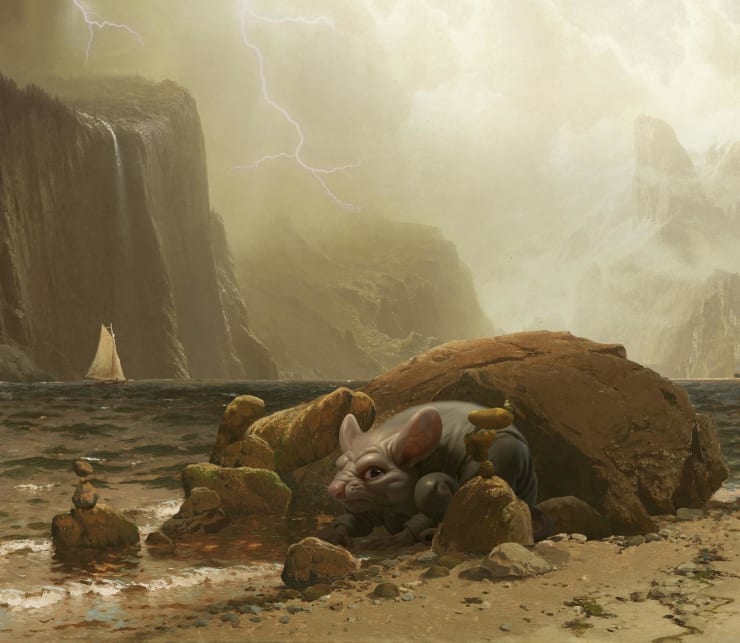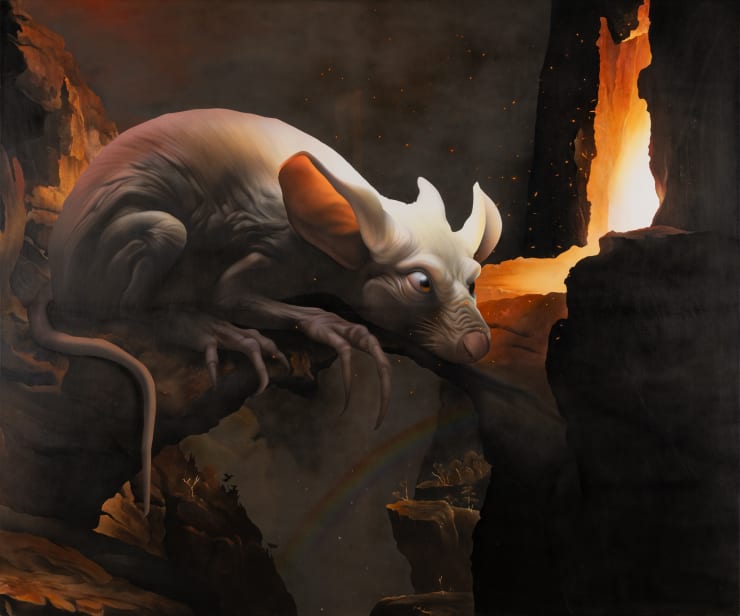马切伊·科什奇: 天鹅绒黎明
马切伊·科斯克(Maciej Kość)于2024年毕业于爱丁堡艺术学院(Edinburgh College of Art),现继续在伦敦皇家艺术学院(Royal College of Art)深造。
《天鹅绒黎明》(Velvet Dawns)是他在VETA by Fer Francés举办的首次个展,此次展览源于他在夏季期间受邀进行的驻地创作。马切伊回忆道:“我试图充分利用VETA的驻地艺术家工作室的条件。工作室离普拉多博物馆和提森博物馆很近,所以我经常去看,既着迷于它们的藏品,也对这些藏品对我创作的潜在影响感到不安。如何抵抗保罗·德·沃斯(Paul de Vos)的《公牛》或戈雅的《拴狗》的吸引力?并且要找到创作的呼吸空间,你还必须承受鲁本斯《银河的诞生》的压力。”
马切伊的创作媒介丰富,以混合技法为主,主要使用丙烯颜料(通过喷枪上色)与软粉彩,绘制于亚麻布画布或木质面板上,有时会加入雕塑感的泡沫元素和拾得物品。他的艺术吸收了多样的风格,从经典绘画、巴洛克、风格主义,到后现代的极繁主义及儿童插画。他汲取灵感于十九世纪崇高的风景画(如哈德逊河画派),拉斐尔前派的经典美学,以及约翰·詹姆斯·奥杜邦(John James Audubon)笔下的鸟类。他同样敬仰当代艺术家,如英国画家彼得·多伊格(Peter Doig)的细腻诗意,沃尔顿·福特(Walton Ford)对假想动物标本的自然主义描绘,以及托马斯·伍德拉夫(Thomas Woodruff)装饰华丽的恐龙形象。他的怪诞画面有时暗示了文学戏谑史诗的复兴,如伊格纳西·克拉西茨基(Ignacy Krasicki)的《鼠史诗》(Mouseiad),或让·德·拉封丹(Jean de La Fontaine)寓言的插画,但马切伊将这些灵感深度整合,形成了独特而现代的艺术风格。
这次展览中包含了一系列壮丽且富有同理心的动物肖像,这些动物以复杂的个性特质示人。展览特别关注常因刻板印象而声名不佳的啮齿类动物,它们有时以卡通形式在较小的作品中出现。然而在整体展览中,这些动物被赋予了新的身份与尊严。它们时而内向、羞怯,时而充满好奇,仰望天空或专注于他物。它们的表情透露出遗憾、伤感或怀旧的复杂情感。马切伊通过他的画面让观众感受到这些动物深刻的主体性——谨慎而脆弱,却也优雅且充满希望。作品暗示着隐秘的叙事与复杂的寓言,但其核心是赋予这些动物特殊的优雅与忧郁。它们的存在感虽小,却不断加强,吸引观众注意到它们的魔力与美感。
马切伊的创作技法融合了喷枪的精细与手工粉彩的丰富质感。粉彩的画法松散、模糊,打破了喷枪技法带来的完美主义,形成了一种绘画性、带有不确定性的美学效果。他花费大量时间专注于创作,沉浸于这些多彩、光感丰富的“天鹅绒与羽毛之兽”的奇幻世界中,为观众打造出梦幻般的视觉体验。
-
 Maciej KośćA Gentle Nurturing Energy to Open The Throat Chakra, 2024Acrylic, expandable foam, mud, polystyrene foam board, static grass strips, leather shoe, chewing gum, epoxy, and gemstones on linen canvas127 x 56.5 x 11 cm
Maciej KośćA Gentle Nurturing Energy to Open The Throat Chakra, 2024Acrylic, expandable foam, mud, polystyrene foam board, static grass strips, leather shoe, chewing gum, epoxy, and gemstones on linen canvas127 x 56.5 x 11 cm
50 x 22 1/4 x 4 3/8 inCourtesy of Veta Galeria SLCopyright The Artist -
 Maciej KośćMaximal Running Speeds of Bipedal Rodents, 2024Acrílico, barro, espuma de poliuretano, cartón, césped artificial, bota y balón de fútbol, calcetín, epoxi, masilla, raíces y arena sobre lienzo/
Maciej KośćMaximal Running Speeds of Bipedal Rodents, 2024Acrílico, barro, espuma de poliuretano, cartón, césped artificial, bota y balón de fútbol, calcetín, epoxi, masilla, raíces y arena sobre lienzo/
Acrylic, expandable foam, mud, polystyrene foam board, cardboard, artificial turf, leather football shoe, football, epoxy, sock, polyfilla, roots, and sand on linen canvas102 x 78 x 12 cm
40 1/8 x 30 3/4 x 4 3/4 inCourtesy of Veta Galeria SLCopyright The Artist -
 Maciej KośćThere’s No One Way to Describe the Sound of a Rat in a Wall, 2024Acrílico, barro, espuma de poliuretano, césped artificial, pelo artificial, epoxi y masilla sobre lienzo/
Maciej KośćThere’s No One Way to Describe the Sound of a Rat in a Wall, 2024Acrílico, barro, espuma de poliuretano, césped artificial, pelo artificial, epoxi y masilla sobre lienzo/
Acrylic, mud, polystyrene foam board, epoxy, artificial fur, grout on wooden panel70 x 40 x 9 cm
27 1/2 x 15 3/4 x 3 1/2 inCourtesy of Veta Galeria SLCopyright The Artist -
 Maciej KośćDaffodils Have Alkaloids Which Are Poisonous to Rodents, 2024Acrílico, barro, espuma de poliuretano, epoxi, césped, hierba y flores artificiales, raíces y arena sobre madera/ Acrylic, mud, polystyrene foam board, epoxy, artificial turf, artificial
Maciej KośćDaffodils Have Alkaloids Which Are Poisonous to Rodents, 2024Acrílico, barro, espuma de poliuretano, epoxi, césped, hierba y flores artificiales, raíces y arena sobre madera/ Acrylic, mud, polystyrene foam board, epoxy, artificial turf, artificial
flowers, artificial tall grass, roots, and sand on wooden panel100 x 50 cm
39 3/8 x 19 3/4 inCourtesy of Veta Galeria SLCopyright The Artist -
 Maciej KośćCranked Shaft to Protect Knuckles During Work, 2024Acrílico, barro, espuma de poliuretano, cartón, césped artificial, epoxi, masilla, cubo y paleta de metal sobre madera/
Maciej KośćCranked Shaft to Protect Knuckles During Work, 2024Acrílico, barro, espuma de poliuretano, cartón, césped artificial, epoxi, masilla, cubo y paleta de metal sobre madera/
Acrylic, mud, polystyrene foam board, epoxy, artificial turf, grout, galvanised metal bucket, steel hand trowel on wooden panel50 x 40 x 13 cm
19 3/4 x 15 3/4 x 5 1/8 inCourtesy of Veta Galeria SLCopyright The Artist -
 Maciej KośćBut What Would the Neighbours Think if I Stopped Mowing the Lawn?, 2024Acrílico, corteza de árbol, barro, espuma de poliestireno, espuma de poliuretano, epoxi, césped artificial, mariposas disecadas, masilla, hojas de aluminio/ Acrylic, tree bark, mud, polystyrene foam board, expandable foam, epoxy,
Maciej KośćBut What Would the Neighbours Think if I Stopped Mowing the Lawn?, 2024Acrílico, corteza de árbol, barro, espuma de poliestireno, espuma de poliuretano, epoxi, césped artificial, mariposas disecadas, masilla, hojas de aluminio/ Acrylic, tree bark, mud, polystyrene foam board, expandable foam, epoxy,
artificial turf, grout, taxidermy butterflies, aluminium foil, and aluminium wire on linen canvas120 x 90 x 25 cm
47 1/4 x 35 3/8 x 9 7/8 inCourtesy of Veta Galeria SLCopyright The Artist -
 Maciej KośćMake war against mice? Are you serious?, 2024Acrílico sobre lienzo/ Acrylic on canvas400 x 250 cm
Maciej KośćMake war against mice? Are you serious?, 2024Acrílico sobre lienzo/ Acrylic on canvas400 x 250 cm
157 1/2 x 98 3/8 inCourtesy of Veta Galeria SLCopyright The Artist -
 Maciej KośćDue to their great size, they can destroy entire settlements , 2024Acrílico sobre lienzo/ Acrylic on canvas62 x 47 cm
Maciej KośćDue to their great size, they can destroy entire settlements , 2024Acrílico sobre lienzo/ Acrylic on canvas62 x 47 cm
24 3/8 x 18 1/2 inCourtesy of Veta Galeria SLCopyright The Artist -
 Maciej KośćElement bearable to no mortal, 2024Acrílico sobre lienzo/ Acrylic on canvas232 x 203 cm
Maciej KośćElement bearable to no mortal, 2024Acrílico sobre lienzo/ Acrylic on canvas232 x 203 cm
91 3/8 x 79 7/8 inCourtesy of Veta Galeria SLCopyright The Artist -
 Maciej KośćA still volcano, Life, that flickered in the night, 2024Acrílico sobre lienzo/ Acrylic on canvas200 x 240 cm
Maciej KośćA still volcano, Life, that flickered in the night, 2024Acrílico sobre lienzo/ Acrylic on canvas200 x 240 cm
78 3/4 x 94 1/2 inCourtesy of Veta Galeria SLCopyright The Artist -
 Maciej KośćThe sun was warm but the wind was chill, 2024Acrílico sobre lienzo/ Acrylic on canvas200 x 200 cm
Maciej KośćThe sun was warm but the wind was chill, 2024Acrílico sobre lienzo/ Acrylic on canvas200 x 200 cm
78 3/4 x 78 3/4 inCourtesy of Veta Galeria SLCopyright The Artist -
 Maciej KośćAt first it was soft gazes, 2024Acrílico sobre lienzo/ Acrylic on canvas137.5 x 167 cm
Maciej KośćAt first it was soft gazes, 2024Acrílico sobre lienzo/ Acrylic on canvas137.5 x 167 cm
54 1/8 x 65 3/4 inCourtesy of Veta Galeria SLCopyright The Artist -
 Maciej KośćOh, hear a pensive captive prayer, 2024Acrílico sobre lienzo/ Acrylic on canvas137.5 x 167 cm
Maciej KośćOh, hear a pensive captive prayer, 2024Acrílico sobre lienzo/ Acrylic on canvas137.5 x 167 cm
54 1/8 x 65 3/4 inCourtesy of Veta Galeria SLCopyright The Artist
Maciej Kość(2001年生于波兰罗兹)于2024年毕业于爱丁堡艺术学院,目前正于享有盛誉的伦敦皇家艺术学院继续深造。
《天鹅绒黎明》(Velvet Dawns)是他在VETA by Fer Francés举办的首次个展,此次展览源于他在夏季期间受邀进行的驻地创作。马切伊回忆道:“我试图充分利用VETA的驻地艺术家工作室的条件。工作室离普拉多博物馆和提森博物馆很近,所以我经常去看,既着迷于它们的藏品,也对这些藏品对我创作的潜在影响感到不安。如何抵抗保罗·德·沃斯(Paul de Vos)的《公牛》或戈雅的《拴狗》的吸引力?并且要找到创作的呼吸空间,你还必须承受鲁本斯《银河的诞生》的压力。”
马切伊的创作媒介丰富,以混合技法为主,主要使用丙烯颜料(通过喷枪上色)与软粉彩,绘制于亚麻布画布或木质面板上,有时会加入雕塑感的泡沫元素和拾得物品。他的艺术吸收了多样的风格,从经典绘画、巴洛克、风格主义,到后现代的极繁主义及儿童插画。他汲取灵感于十九世纪崇高的风景画(如哈德逊河画派),拉斐尔前派的经典美学,以及约翰·詹姆斯·奥杜邦(John James Audubon)笔下的鸟类。他同样敬仰当代艺术家,如英国画家彼得·多伊格(Peter Doig)的细腻诗意,沃尔顿·福特(Walton Ford)对假想动物标本的自然主义描绘,以及托马斯·伍德拉夫(Thomas Woodruff)装饰华丽的恐龙形象。他的怪诞画面有时暗示了文学戏谑史诗的复兴,如伊格纳西·克拉西茨基(Ignacy Krasicki)的《鼠史诗》(Mouseiad),或让·德·拉封丹(Jean de La Fontaine)寓言的插画,但马切伊将这些灵感深度整合,形成了独特而现代的艺术风格。
这次展览中包含了一系列壮丽且富有同理心的动物肖像,这些动物以复杂的个性特质示人。展览特别关注常因刻板印象而声名不佳的啮齿类动物,它们有时以卡通形式在较小的作品中出现。然而在整体展览中,这些动物被赋予了新的身份与尊严。它们时而内向、羞怯,时而充满好奇,仰望天空或专注于他物。它们的表情透露出遗憾、伤感或怀旧的复杂情感。马切伊通过他的画面让观众感受到这些动物深刻的主体性——谨慎而脆弱,却也优雅且充满希望。作品暗示着隐秘的叙事与复杂的寓言,但其核心是赋予这些动物特殊的优雅与忧郁。它们的存在感虽小,却不断加强,吸引观众注意到它们的魔力与美感。
马切伊的创作技法融合了喷枪的精细与手工粉彩的丰富质感。粉彩的画法松散、模糊,打破了喷枪技法带来的完美主义,形成了一种绘画性、带有不确定性的美学效果。他花费大量时间专注于创作,沉浸于这些多彩、光感丰富的“天鹅绒与羽毛之兽”的奇幻世界中,为观众打造出梦幻般的视觉体验。
















